Strawberries, or as they are called garden strawberries, are very popular among gardeners all over the world. The strawberry variety Tsaritsa is characterized by unpretentiousness to care and living conditions, besides such berries can boast of large size and excellent taste.
Table of contents
Description strawberry variety queen
Let's start with the description of the berries. Variety of garden strawberries Tsaritsa was bred in Russia, professor and breeding specialist S.D. Aitzhanova. The plant was born by crossing the strawberries "Venta" and "Red Hotlenta." Learned plant boasts good survival in various conditions. Small bushes are not afraid of frost, drought, heat, most common diseases and pests.
In appearance, the Queen is a low, compact bushes, consisting of dark green leaves of medium size, on which there is no characteristic for the culture of the pubescence. Antennae reddish, covered with small hairs. Flowers are fairly large, white, bisexual, appear on the bushes in small quantities.
Fruiting varieties occur at a later date, so it will be possible to pick ripe berries only at the end of June. For many gardeners, this quality plays an important role, because when other bushes stop producing their crops, the Queen will only begin to delight everyone with tasty fruits.
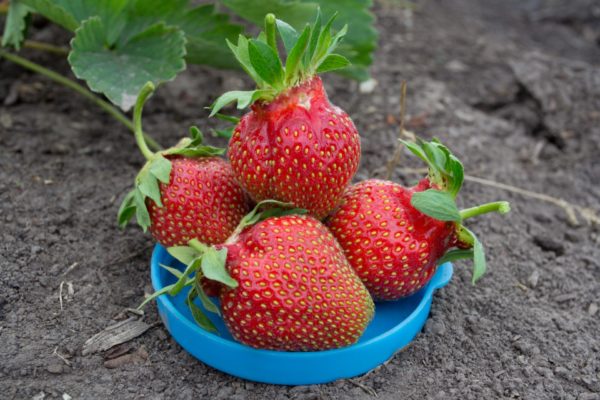
With one hectare of landings can be collected up to 13 tons of crop. Berries of medium size (40-50 grams) have the correct conical shape, extended at the base.Strawberries look very appetizing because they are colored bright red.
Fruits are smooth on the outside and dense and very juicy on the inside. They have a sweet-sour taste and a bright aroma that strongly resembles the smell of wild strawberries. The resulting crop is well suited for transportation and storage. Berries are suitable both for fresh consumption and for various preparations.
Natural growth region
The queen was bred with the harsh Russian climateThat is why this variety is not afraid of frosty winters and tolerates various temperature drops. You can grow both in the south and in the north.
Small bushes are not afraid of summer heat and drought. In winter, under the snow cover, they are able to tolerate frosts down to -40 degrees. Without cover, this mark is significantly reduced (to -20 degrees), so if winter is given a little snowy plant, it is better to cover it additionally.
Advantages and disadvantages
Grade advantages:
- the berries are large, juicy and very tasty, the tasting score is 4.8 points;
- fruits are universal, suitable for various types of use;
- strawberry tolerates transportation and is stored for a long time;
- unpretentious to care and growing conditions;
- the variety has high frost resistance and tolerates drought with ease;
- the bush is not afraid of diseases and pests;
- able to bear fruit for 4-5 years.
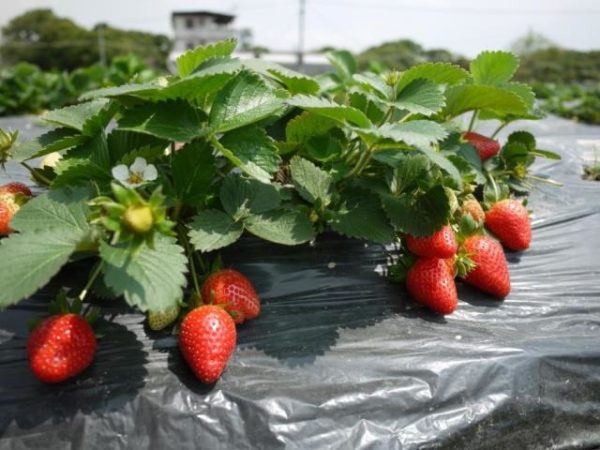
Disadvantages:
- even though the plant is not afraid of cold, it can die if there is insufficient snow cover, so you should definitely follow this indicator;
- yields are average, so using varieties for an industrial scale will not bring the desired results.
Planting and care
Before planting a plant, it is necessary to pick up healthy seedlings, from which strong fruit-bearing bushes will be able to grow in the future. Experienced gardeners recommend paying attention to the fact that there are at least 4 healthy leaves on a strawberry, and the roots are at least 10 centimeters long.
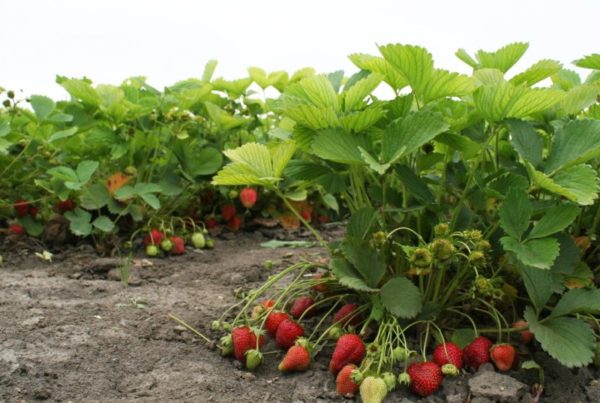
In order for the Queen to feel comfortable, it is necessary to provide her with all the necessary conditions, which include:
- the landing area must be even and well lit;
- good air circulation is encouraged;
- in the neighborhood should not be located high plants, shrubs and trees, as well as solanaceous crops;
- the soil should be drained, light and fertile, loams are suitable for such purposes.
Landing guidelines
It is recommended to plant the Queen in the beds in the spring, namely in the middle of April. This is due to the fact that during the autumn planting the root system of seedlings will not have time to get stronger before the onset of cold weather. In order to prepare a fertile soil, in the fall six months before planting strawberries, the soil is dug up and the following fertilizers are applied to 1 square meter:
- 2 buckets of mullein or humus;
- 30 grams of wood ash;
- 50 grams of urea.
There are two popular methods for planting plants:
- Belt - for this you need to dig grooves with a depth of 15 centimeters and a width of 40 centimeters. Individual bushes are located at a distance of 20 centimeters from each other;
- When planting seedlings in the hole, the same parameters remain, the only difference is that each bush is planted in a separate hole.
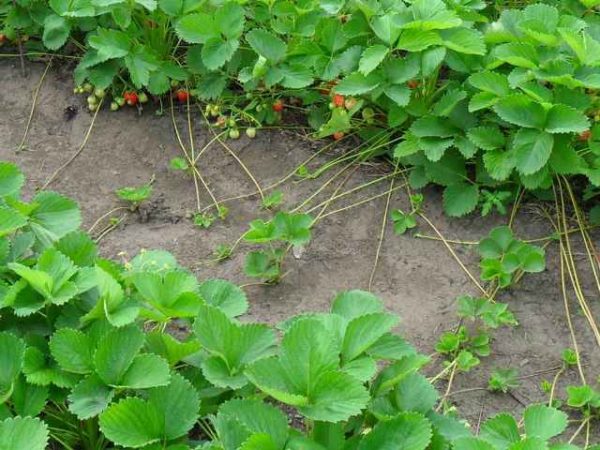
The final stage will be abundant watering and mulching plantings.
Basic rules for the care of berries
In order for the plant to bring a good harvest, he needs proper and high-quality care, which is in many nuances.
Watering strawberries should be abundant, but not excessive. During flowering, setting and ripening of fruits, the soil is moistened once in 10-12 days, using 2-3 buckets of water for one bush. The rest of the time, the amount of watering is reduced to 1 time in 3 weeks.
After each watering, it is recommended to additionally mulch the planting with peat, straw or dry leaves. Also, do not forget about weeding, loosening and timely removal of extra whiskers.
The fertilizer application is as follows:
- In the spring, the beds clear and apply nitrogen and mineral fertilizers, which include ash and urea;
- During the flowering of the formation of ovaries, potash fertilizers, iron or manganese are introduced into the soil;
- In the fall, one bucket of humus or half a bucket of peat mixed with the same amount of sawdust is brought in for one square meter.Mineral fertilizers can be added to the fertile mixture.
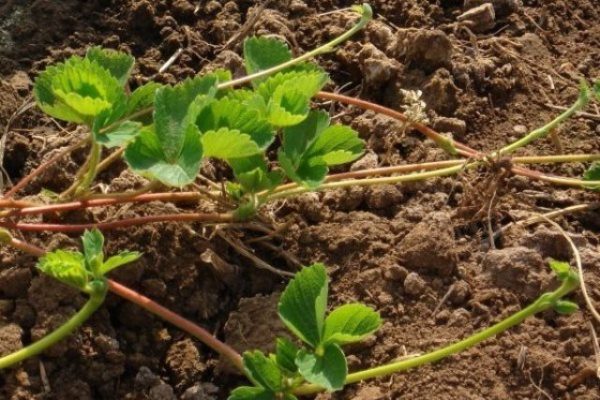
For additional protection in winter, planting is covered with spruce branches or agrofibre.
Breeding
Reproduction of the Queen with the help of seeds extremely rarely succeeds, because the resulting plants do not retain the main features of the mother plant, become less stable, and the berries lose their taste and size. In order to obtain seedlings from seeds perform the following steps:
- 2-3 months before planting, the seeds are washed, dried and laid out in a container with sand, then sprinkled with a thin layer of soil;
- the main care will be timely watering.
The most popular vegetative breeding method will be the use of whiskers, that is, processes appearing in adult plants.
- First, choose the most healthy mustache, the rest are removed;
- The first outlet is instilled into the ground, and is looked after as seedlings;
- Once the core is formed and 3-4 leafy rosettes of the plant can be divided.
Another way is that an adult, spreading plant is dug out of the ground and divided into several parts, each of which must contain several leaf rosettes and developed roots. The resulting bushes are planted as separate plants.
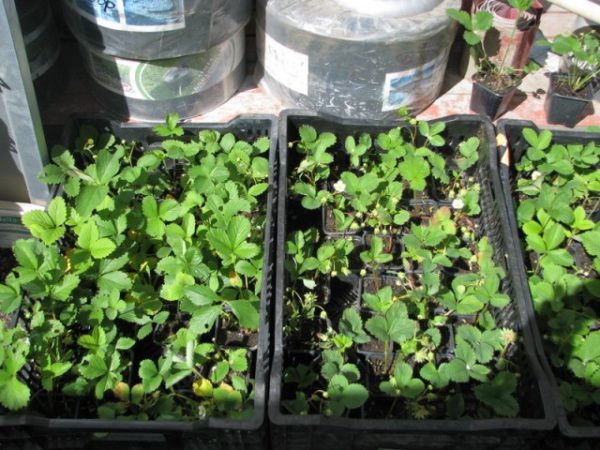
Features of growing
The queen is considered an unpretentious variety with good yields, but when growing such a plant it is worth considering a few nuances:
- In rainy and cloudy weather, the amount of watering should be reduced in order to avoid stagnation of moisture and decay of the root system;
- With high-quality fertilizer ridges before planting, the first dressings can be applied only in the third year of the plant's life;
- Berries ripen unevenly, so you need to carefully inspect all the bushes and collect only ripe fruits;
- Experienced gardeners recommend harvesting after the dew has come down;
- With the age of the bush, the berries begin to shrink, therefore the plantings are renewed every 4-5 years.
Diseases and pests
Variety Queen is not subject to the emergence of various kinds of diseases, but pests can easily settle on such a plant. The most dangerous are the larvae of the May beetle and the wireworm, against which the spillage of the soil with an ammonia solution helps.

Also a significant damage can cause a strawberry transparent tick, which can be eliminated with the help of karbofos or special insecticides.
As a preventive measure, you must follow all the rules for the care of strawberries and carry out regular treatments with Brodsky liquid or soapy water.
The queen is a very decent variety of strawberries, popular throughout Russia. Its main advantages will be the excellent taste of berries and unpretentiousness to climatic conditions, thanks to which the plant can be grown even in the northern regions.
